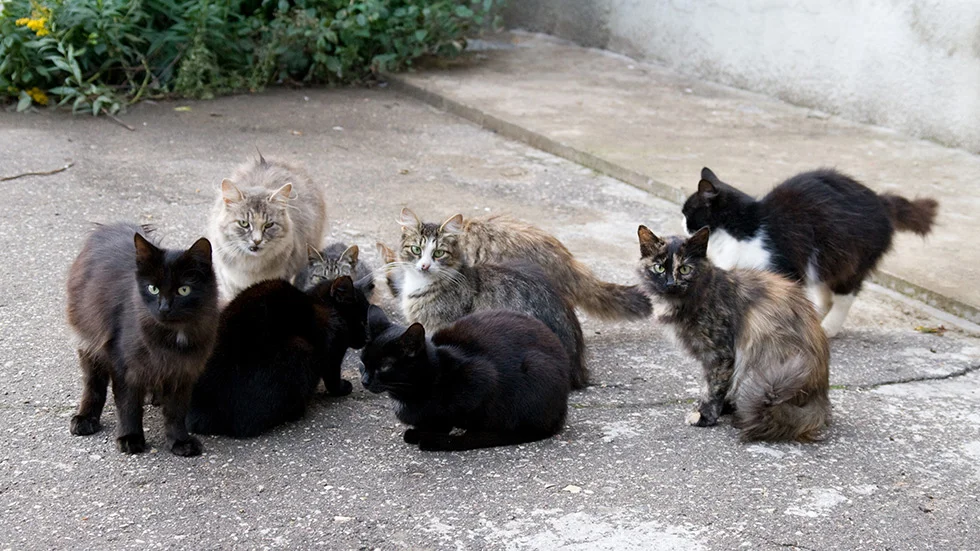חתולי קהילה, המכונים לעתים קרובות חתולי רחוב או חתולי פרא, הם מחזה נפוץ בשכונות רבות של מרוקו. חתולים אלו חיים בחוץ ולרוב אינם בבעלות איש, אך הם ממלאים תפקיד משמעותי במערכת האקולוגית המקומית. באגודה ההומנית של מרוקו, אנו מחויבים להתמודד עם האתגרים הייחודיים העומדים בפני חתולי הקהילה באמצעות פתרונות אנושיים ויעילים.
היוזמות שלנו לחתולי קהילה כוללות תוכניות מלכודת-סירוס-חיסון-החזרה (TNVR), המסייעות לשלוט באוכלוסיה ולשפר את בריאותם של חתולים אלו. על ידי תפיסה אנושית של חתולי קהילה, עיקור או סירוסם, ולאחר מכן החזרתם לטריטוריות שלהם, אנו מצמצמים את מספר הגורים הנולדים ברחוב ומשפרים את הרווחה הכללית של החתולים הבוגרים.
כמו כן, אנו פועלים להעלאת המודעות לחשיבותם של חתולי קהילה ומקדמים אסטרטגיות דו קיום המועילות הן לחתולים והן לקהילות שבהן הם גרים. באמצעות חינוך ושיתוף פעולה, אנו שואפים ליצור סביבה בטוחה ובריאה יותר עבור חתולי קהילה ברחבי מרוקו.

לפעמים כאשר אנו רואים חתול בקהילה, אנו עשויים לחשוב שהם זקוקים לעזרתנו. הנה כמה טיפים על מה כדאי - ואסור - לעשות כאשר נתקלים בחתול קהילה במרוקו
מהו חתול קהילה?
חתולי קהילה הם החתולים שאנו רואים בקהילה שלנו. חתולים אלה מגיעים ממגוון רחב של רקעים. כמה חתולי קהילה הם פראיים. כמה חתולי קהילה היו בעבר בבעלותם וננטשו. חתולי קהילה אחרים נמצאים בבעלותם אך נמצאים בחוץ ליד ביתם.
חתולי קהילה נקראים בשמות רבים: חתולי שכונה, חתולי רחוב, חתולים משוטטים ועוד. בעיקרו של דבר, כל חתול שאתה נתקל בחוץ הוא חתול קהילתי.
איך אני יכול לעזור לחתולים בקהילה?
כאשר אתה רואה חתול בקהילה, השאלה הראשונה שאתה חייב לשאול היא:האם החתול בריא? אם החתול נראה בריא ולא נפגע הדבר הטוב ביותר שאתה יכול לעשות הוא להשאיר אותו בשקט. עדיף להשאיר את החתול לבד כי:
החתול שאני רואה לא נראה פצוע ו/או לא בריא. מה עלי לעשות?
אם החתול נראה בריא ולא פצוע, הדבר הטוב ביותר לעשות הוא להשאיר את החתול בשקט.
אם החתול זקוק לסיוע רפואי, התקשר לוטרינר.
אני לא אוהב כשחתולי הקהילה נכנסים לחצר שלי. מה אני יכול לעשות כדי להרתיע אותם?
חשוב לזכור שהוצאת חתול מהאזור שלך לא תפחית את מספר החתולים. אם יש מקור מזון או מים קרוב, חתולים נוספים יעברו לאזור.
עם זאת, יש הרבה דרכים אנושיות להרתיע חתולי קהילה מלהיכנס לחצר שלך. סביר להניח שחתולי קהילה משתמשים בחלל שלך מכיוון שהוא מספק מקור מזון או מחסה. הסרת מקורות מזון וחסימת הגישה למקומות מסתור יכולים להרתיע חתול בקהילה. אתה יכול גם:
למידע נוסף, בקר בעמוד שלנו: מרתיע חתולים משוטטים.
לא אכפת לי שיהיו חתולי קהילה בחצר שלי. מה אני יכול לעשות כדי לעזור להם?
כמה מועצות עירוניות, ארגוני צדקה או אפילו שכנים מנהלים תוכנית מלכודת, סירוס והחזרה לחתולים באזורים שאינם מגורים. הוא נועד לשפר את חייהם של חתולי קהילה ולהפחית את מספרם. חתולים באזורים שאינם מגורים נלכדים על ידי אנשים כמוך, מובאים לווטרינר לניתוח עיקור/סירוס, מחוסנים ואז משוחררים בחזרה לקהילה שלהם.
באזורים מסוימים של מרוקו, אנו חווים מזג אוויר קיצוני - גם חם וגם קר. מצא את הטיפים שלנו לטיפול בחתולי קהילה במזג אוויר קר ובמזג אוויר חם.
| עוּגִיָה | מֶשֶׁך | תֵאוּר |
|---|---|---|
| cookielawinfo-checkbox-analytics | 11 חודשים | This cookie is set by GDPR Cookie Consent plugin. The cookie is used to store the user consent for the cookies in the category "Analytics". |
| cookielawinfo-checkbox-functional | 11 חודשים | The cookie is set by GDPR cookie consent to record the user consent for the cookies in the category "Functional". |
| cookielawinfo-checkbox-necessary | 11 חודשים | This cookie is set by GDPR Cookie Consent plugin. The cookies is used to store the user consent for the cookies in the category "Necessary". |
| cookielawinfo-checkbox-others | 11 חודשים | This cookie is set by GDPR Cookie Consent plugin. The cookie is used to store the user consent for the cookies in the category "Other. |
| cookielawinfo-checkbox-performance | 11 חודשים | This cookie is set by GDPR Cookie Consent plugin. The cookie is used to store the user consent for the cookies in the category "Performance". |
| מדיניות_צפייה_עוגיות | 11 חודשים | קובץ ה-cookie מוגדר על ידי תוסף GDPR Cookie Consent ומשמש לאחסון בין אם המשתמש הסכים לשימוש בעוגיות ובין אם לאו. זה לא שומר נתונים אישיים. |